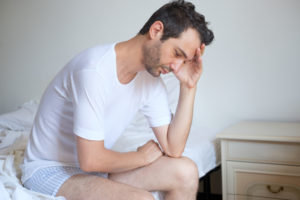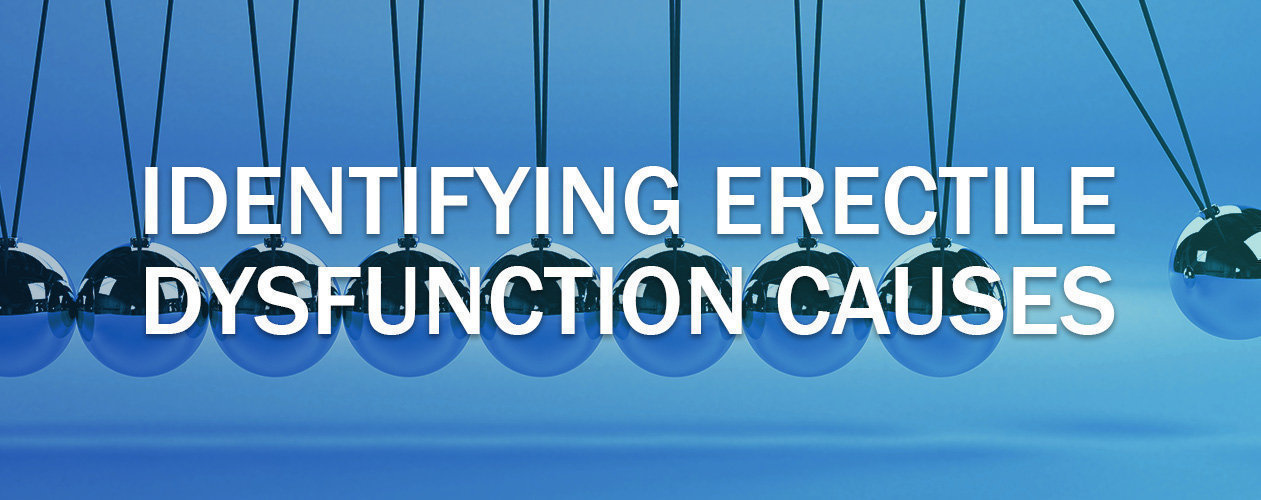Identifying Erectile Dysfunction Causes
Short facts about ED
- ED is a worldwide condition affecting both men and women.
- ED is defined as the inability to achieve or maintain an erection of enough rigidity for vaginal penetration and completion of the sexual act.
- The prevalence of ED is anticipated to increase from 152 million in 1995 to 322 million by 2025.
- ED affects 50% of men older than 40 years.
- Major causes for ED include ageing, cardiovascular diseases such as atherosclerosis and hypertension, diabetes and radical prostatectomy.
- Lifestyle choices can make you more prone to EDs; alcoholism, drug use, being overweight, smoking, certain medications, and even “prolonged bicycling” can lead to ED.
- ED can cause psychological stress, and psychological stress can cause ED; when men are frustrated by their inability to perform, it can make it even more difficult to overcome ED.

What is ED?
ED represents the persistent inability to attain and maintain an erection sufficient to permit satisfactory sexual performance for at least 3 months. ED has a significant impact on the physical and psychological health of men worldwide and can also affect the quality of life of both the sufferers and their partners.
Penile erection is a complex phenomenon which involves a delicate and coordinated balance between neurological, vascular and tissue compartments. This includes arterial dilation, relaxation of the trabecular smooth muscle, and activation of the corporeal veno-occlusive mechanism.
The most common risk factors for ED include cardiovascular disease, hypertension, diabetes mellitus, hyperlipidemia, hypogonadism, lower urinary tract symptoms, metabolic syndrome, depression and smoking.
ED affects more than 150 million men worldwide, affecting men of different ages, even younger ones.
ED symptoms may appear to most men as transient, but in fact, the symptomatology is persistent. It can cause a lot of frustration if not treated. Most cases that confront with ED don’t admit that they have this problem and refuse to get an appointment to the sexologist.
Symptoms of ED
Signs and symptoms of ED may differ from person to person. Some men may be able to sustain an erection for a short period of time, while other men might exhibit a complete inability to achieve an erection.
These signs and symptoms include:
- Difficulty achieving an erection;
- Inability to sustain an erection;
- Inability to have an erection;
- Premature ejaculation;
- Delayed ejaculation;
- Inability to ejaculate;
- Reduced libido or sex drive;
- A dysfunction in the muscles of the pelvic floor;
- Trauma to the pelvis, such as pelvic fractures;
- Failure to become aroused after sufficient stimulation, which is a condition known as anorgasmia;
- Low levels of the hormone testosterone;
What is the mechanism of penile erection?
Anatomy of the penis
The penis is composed of the following components:
- Two chambers called the corpora cavernosa which function as blood-filled capacitors providing structure to the erect organ;
- Urethra, the channel for urine and sperm;
- Erectile tissue, which surrounds the urethra, two main arteries and several veins and nerves;
- Shaft, the longest part of the penis;
- The head (glans), placed at the end of the shaft;
- The meatus or opening at the tip of the head where urine and semen are discharged.
How does an erection occur?
The penis physiological states of flaccidity or erection result from the contraction or relaxation, respectively, of smooth muscle cells in the corpus cavernosum. The balance between contraction and relaxation is controlled by central and peripheral factors that involve many transmitters and transmitter systems. Factors that mediate contraction in the penis include noradrenaline, endothelin-1, neuropeptide Y, prostanoids, angiotensin II, and others not yet identified. Factors that mediate relaxation include acetylcholine, nitric oxide (NO), vasoactive intestinal polypeptide, pituitary adenylyl cyclase–activating peptide, calcitonin gene-related peptide, adrenomedullin, adenosine triphosphate, and adenosine prostanoids.
Penile erection is a spinal reflex that is initiated by autonomic and somatic penile afferents and by supraspinal influences from visual, olfactory, and imaginary stimuli. There are several central transmitters involved in the erectile control, some of them with a facilitatory role and others with an inhibitory role.
The central transmitters with a facilitatory role in the penile erection are:
- dopamine,
- acetylcholine,
- nitric oxide (NO),
- peptides, such as oxytocin and adrenocorticotropin/α-melanocyte-stimulating hormone.
The central transmitters that inhibit the penile erection are serotonin which may be either facilitatory or inhibitory, and enkephalins which are inhibitory.
Nitric oxide is released during sexual stimulation. It activates the enzyme called guanylate cyclase, resulting in an increased level of cyclic guanosine monophosphate (cGMP) in the corpus cavernosum. This, in turn, results in smooth muscle relaxation, allowing increased inflow of blood into the penis. The level of cyclic guanosine monophosphate is regulated by the rate of synthesis via guanylate cyclase and by the rate of degradation via cyclic guanosine monophosphate hydrolysing phosphodiesterases (PDEs).
Role of testosterone in the mechanism of erection
Both ED and low testosterone (hypogonadism) increase with age. The incidence of the latter is 40% in men aged 45 years and older. Testosterone is known to be important in the mood, cognition, vitality, bone health, and muscle and fat composition. It also plays a key role in sexual dysfunction such as low libido, poor erection quality, ejaculatory or orgasmic dysfunction, reduced spontaneous erections, or reduced sexual activity.
The association between low testosterone and ED is not entirely clear.
The role of testosterone supplementation in hypogonadal men with ED was assessed in a clinical trial. Men included in the trial were considered non-responders to sildenafil and their erections were monitored by assessing nocturnal penile tumescence (NPT).
After 6 months of testosterone administered intradermal, the number of NPTs increased, as did the maximum rigidity with sildenafil. The study suggests that a certain level of testosterone may be necessary for phosphodiesterase type 5 inhibitors to function properly.
Another study compared the response of surgically and medically castrated rabbits to vardenafil with that of control rabbits. Castrated rabbits did not respond to vardenafil, whereas non-castrated rabbits did respond appropriately. This result suggests that a minimum amount of testosterone is necessary for phosphodiesterase type 5 inhibitors to produce an erection.
Possible Erectile Dysfunction Causes
Organic, physiologic, endocrine, and psychogenic factors are involved in the ability to obtain and maintain erections. Several medical conditions may affect erectile function by altering the nervous the nervous, vascular, or hormonal systems. Various diseases may produce changes in the smooth muscle tissue of the corpora cavernosa or influence the patient’s psychological mood and behaviour.
Vascular diseases
Approximately 50% of all cases of ED in men older than 50 years are determined by vascular diseases. These diseases include:
- Atherosclerosis;
- Peripheral vascular disease;
- Myocardial infarction;
- Arterial hypertension.
Other vascular causes of ED include:
- Vascular injury from radiation therapy: data indicate that 50% of men undergoing radiation therapy lose erectile function within 5 years after completing therapy; fortunately, some respond to one of the phosphodiesterase type 5 inhibitors.
- Vascular injury from prostate cancer treatment.
- Blood vessel and nerve trauma: bicycle riding for long periods has been implicated as an etiologic factor; direct compression of the perineum by the bicycle seat may cause vascular and nerve injury. On the other hand, bicycling for less than 3 hours per week may be somewhat protective against ED.
Systemic diseases
- Diabetes mellitus: according to a systematic review and a meta-analysis the prevalence of ED was 37.5% in type 1 diabetes, 66.3% in type 2 diabetes, and 52.5% in diabetes overall, a rate approximately 3.5 times higher than that in controls. The aetiology of ED in diabetic men probably involves both vascular and neurogenic mechanisms;
- Arterial hypertension;
- Scleroderma;
- Renal failure;
- Liver cirrhosis;
- Idiopathic hemochromatosis;
- Cancer;
- Dyslipidemia.
Neurologic diseases
- Epilepsy;
- Stroke;
- Multiple sclerosis;
- Guillain-Barré syndrome;
- Alzheimer disease.
Respiratory conditions
- Chronic obstructive pulmonary disease;
- Sleep apnea.
Endocrine conditions
- Hyperthyroidism;
- Hypothyroidism;
- Hypogonadism.
Penile conditions
- Peyronie disease;
- Epispadias;
- Priapism.

Psychiatric conditions
Mental health disorders are likely to affect sexual performance. These disorders include:
- Depression;
- Widower syndrome;
- Performance anxiety;
- Posttraumatic stress disorder.
Hematologic diseases
- Sickle cell anemia;
- Leukemia.
Surgical procedures
- Prostate surgery for benign prostatic hyperplasia: this association is thought to be related to nerve damage from cauterization. Newer procedures like microwave, laser, or radiofrequency ablation have rarely been associated with ED;
- Radical prostatectomy for the treatment of prostate cancer: a number of factors are associated with the chance of preserving erectile function. If both nerves that course on the lateral edges of the prostate can be saved, the chance of maintaining erectile function is reasonable. The odds depend on the age of the patient. Men younger than 60 years have a 75-80% chance of preserving potency, but men older than 70 years have only a 10-15% chance;
- Brain and spinal cord procedures;
- Retroperitoneal or pelvic lymph node dissection;
- Aortoiliac or aortofemoral bypass;
- Abdominal perineal resection;
- Proctocolectomy;
- Transurethral resection of the prostate;
- Cryosurgery of the prostate;
- Cystectomy.
What drugs cause ED?
Patients who are taking medications and suffering from ED should consult their healthcare professional to see if any of the drugs may be a cause of the problem. These drugs include also the illicit and/or recreational drugs. Drugs and medications that cause ED or other sexual problems as side effects are commonly prescribed for men without them knowing the risks.
Drugs that could be involved in the occurrence of ED are:
- drugs to control high blood pressure;
- heart medications (digoxin);
- some diuretics;
- drugs that act on the central nervous system, including some sleeping pills and amphetamines;
- anxiety treatments;
- antidepressants (monoamine oxidase inhibitors, selective serotonin reuptake inhibitors and tricyclic antidepressants);
- opioid painkillers;
- some cancer drugs, including chemotherapeutic agents;
- prostate treatment drugs;
- anticholinergics;
- hormone drugs;
- peptic ulcer medication (cimetidine).
Diet and ED
Consumption of foods that contain cancer-promoting substances and promote inflammation such as high-fat diet, red meat, fruits and vegetables low in fibre and whole grains highly increases the risk of developing ED.
On the other side, a diet rich in antioxidants boosts the production of nitric oxide, which has an important role in erectile function and prevents the development of ED.
Diagnostic evaluation of ED
The diagnostic evaluation of ED is based on:
- Sexual, medical and psychological history of the patient;
- Physical examination;
- Laboratory testing;
- Imaging testing.
Can ED be cured? What are the available treatments?
Phosphodiesterase-5 inhibitors represent the most commonly used class of drugs in the treatment of ED. These medications are highly efficacious, are well tolerated, and have very favourable safety profiles. Four phosphodiesterase type 5 inhibitors are available on market: sildenafil (Viagra®, Pfizer), vardenafil (Levitra®, Bayer), tadalafil (Cialis®, Lilly-ICOS) and avanafil (Stendra®). These agents do not directly cause penile erections but instead affect the response to sexual stimulation. Sildenafil (Viagra) was the first in this series of phosphodiesterase type 5 inhibitors.
Phosphodiesterase type 5 inhibitors are recommended as the first-line therapy for ED. According to the European guidelines the choice between a short-acting phosphodiesterase type 5 inhibitor and a long-acting phosphodiesterase type 5 inhibitor depends on the frequency of intercourse (occasional use or regular therapy, 3-4 times weekly) and the patient’s personal experience.
Other treatments for ED include:
- Alprostadil self-injection;
- Alprostadil urethral suppository;
- Testosterone replacement;
- Penis pumps, surgery and implants;
- Psychological counselling;
- Alternative medicine: arginine, yohimbine, ginkgo biloba, ginseng.
Complications of EDs
Complications of ED include:
- Relationship troubles and lack of intimacy;
- Difficulty getting your partner pregnant;
- Increased stress;
- Depression;
- Anxiety;
- Low self-esteem or low self-worth;
- Feeling discouraged by unsatisfying sex life.

Prevention of ED
- Be more careful with nutrition:
- Foods that can cause heart attacks due to restricted blood flow in the coronary arteries can also impede blood flow to and within the penis. Diets that include very few fruits and vegetables along with lots of high-fat, fried, and processed foods can contribute to decreased blood circulation throughout the body. Also, studies have shown that ED is relatively uncommon among men who eat a traditional Mediterranean diet, which includes fruits, vegetables, whole grains, heart-healthy fats including nuts and olive oil, fish, and wine, particularly red.
- Maintain a healthy weight:
- Men who are overweight can bring many health problems such as type 2 diabetes. Type 2 diabetes can cause nerve damage throughout the body including the nerves that supply the penis.
- Avoid high blood pressure and high cholesterol:
- High cholesterol or high blood pressure can damage blood vessels, including those that bring blood to the penis.
- Drink alcohol in moderation:
- Chronic consumption of alcohol can cause liver damage, nerve damage, and other conditions which can interfere with the normal balance of male sex hormone levels, so that can lead to the occurrence of ED.
- Exercise regularly:
- A sedentary lifestyle causes ED. Running, swimming, and other forms of aerobic exercise have been shown to help prevent ED.
- Do not rely on Kegels:
- Kagel exercise, also known as pelvic floor exercise, consists of repeatedly contracting and relaxing the muscles that form part of the pelvic floor, now sometimes colloquially referred to as the “Kegel muscles.” Kegels can be helpful for men and women suffering from incontinence, but there’s no evidence that they prevent ED.
- Keep track of testosterone:
- Even in healthy men, testosterone levels often begin falling sharply around age 50. Every year after age 40, a man’s testosterone level typically falls about 1.3%.
- Avoid anabolic steroids:
- The administration of anabolic steroids, drugs which are often abused by athletes and bodybuilder, should be avoided. These drugs can contract the testicles and block their ability to make testosterone.
- Stop smoking:
- Smoking cigarettes can harm blood vessels and curb blood flow to the penis. The nicotine makes blood vessels contract, which can hamper blood flow to the penis.
- Avoid stress:
- Psychological stress boosts levels of the hormone adrenaline, which makes blood vessels contract.
References
- Yoshimura N, Kato R, Chancellor M, Nelson J, Glorioso J. Gene therapy as future treatment of erectile dysfunction. Expert Opinion on Biological Therapy. 2010;10(9):1305-1314.
- Ismail E, El-Sakka A. Innovative trends and perspectives for erectile dysfunction treatment: A systematic review. 2018.
- https://emedicine.medscape.com/article/444220-overview#a2
- https://www.healthline.com/health/erectile-dysfunction/surprising-facts#2
- K. Hatzimouratidis (Chair), F. Giuliano, I. Moncada, A. Muneer, A. Salonia (Vice-chair), P. Verze EAU Guidelines on Erectile Dysfunction, Premature Ejaculation, Penile Curvature and Priapism
- Bella A, Lee J, Carrier S, Bénard F, Brock G. 2015 CUA Practice guidelines for erectile dysfunction. Canadian Urological Association Journal. 2015;9(1-2):23
- DeLay K, Haney N, Hellstrom W. Modifying Risk Factors in the Management of Erectile Dysfunction: A Review. The World Journal of Men’s Health. 2016;34(2):89. Risk factors
- https://www.verywellhealth.com/erectile-dysfunction-signs-symptoms-and-complications-4160525
- https://my.clevelandclinic.org/health/articles/10036-erection-ejaculation-how-it-occurs
- http://pharmrev.aspetjournals.org/content/63/4/811
- https://emedicine.medscape.com/article/444220-overview#a4
- https://emedicine.medscape.com/article/444220-overview#a5
- https://www.medscape.com/answers/444220-69929/what-is-the-role-of-vascular-diseases-in-the-etiology-of-erectile-dysfunction-ed
- https://www.medicalnewstoday.com/articles/5702.php
- https://prostate.net/health-centers/erectile-dysfunction/causes-erectile-dysfunction/lifestyle-factors
- https://www.healthline.com/health/erectile-dysfunction-tests#tests
- https://emedicine.medscape.com/article/444220-clinical?src=refgatesrc1#showall
- https://www.mayoclinic.org/diseases-conditions/erectile-dysfunction/diagnosis-treatment/drc-20355782
- https://www.webmd.com/erectile-dysfunction/features/protect-your-erection-11-tips#1

